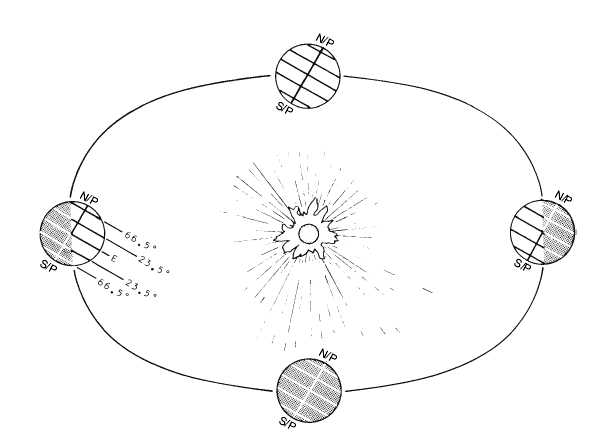In December, the situation is exactly reversed from
that in June. The Southern Hemisphere now receives
more of the Sun’s direct rays. The most perpendicular
rays of the Sun are received at 23 1/2°S latitude (the
Tropic Of Capricorn). The southern polar region is now
completely in sunshine and the northern polar region is
completely in darkness.
Since the revolution of Earth around the Sun is a
gradual process, the changes in the area receiving the
Sun’s rays and the changes in seasons are gradual.
However, it is customary and convenient to mark these
changes by specific dates and to identify them by
specific names. These dates are as follows:
1.
March 21. The vernal equinox, when Earth’s
axis is perpendicular to the Sun’s rays. Spring begins in
the Northern Hemisphere and fall begins in the
Southern Hemisphere.
2.
June 21. The summer solstice, when Earth’s
axis is inclined 23 1/2° toward the Sun and the Sun has
reached its northernmost zenith at the Tropic of Cancer.
Summer
officially
commences
in
the
Northern
Hemisphere;
winter
begins
in
the
Southern
Hemisphere.
3.
September 22. The autumnal equinox, when
Earth’s axis is again perpendicular to the Sun’s rays.
This date marks the beginning of fall in the Northern
Hemisphere and spring in the Southern Hemisphere. It
is also the date, along with March 21, when the Sun
reaches its highest position (zenith) directly over the
equator.
4.
December 22. The winter solstice, when the
Sun has reached its southernmost zenith position at the
Tropic of Capricorn. It marks the beginning of winter in
the Northern Hemisphere and the beginning of summer
in the Southern Hemisphere.
In some years, the actual dates of the solstices and
the equinoxes vary by a day from the dates given here.
This is because the period of revolution is 365 1/4 days
and the calendar year is 365 days except for leap year
when it is 366 days.
Because of its 23 1/2° tilt and its revolution around
the Sun, five natural light (or heat) zones according to
the zone's relative position to the Sun's rays mark Earth.
Since the Sun is ALWAYS at its zenith between the
Tropic of Cancer and the Tropic of Capricorn, this is the
hottest zone. It is called the Equatorial Zone, the Torrid
Zone, the Tropical Zone, or simply the Tropics.
1-7
AGF0104
MARCH 21
SEPTEMBER
22
JUNE 21
SUN
DECEMBER
22
Figure 1-4.—Revolution of Earth around the sun.

